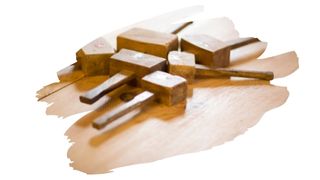When it comes to selecting lumber for your mallet, the most important thing you need to consider is density. For example, is that timber going to be hard enough to drive dowels into place?
You see, dense tough hardwoods are going to do a better job at handling the jarring impact of each knock. So, what should you specifically check for when it comes to selecting a wooden mallet?
Well, in this post, you will find out which popular affordable hardwoods are widely used for making wooden mallets. You will also learn why dense hardwoods are better for making mallets with.
And keep reading to discover how heavy your own handmade wooden mallet should be.

This post may contain affiliate links to products that we receive a commission for (at no additional cost to you). Learn more here.
What Type Of Wood Is Typically Used For Wooden Mallets?
The most suitable wood type for a mallet needs to be dense — certainly dense enough that it won’t splinter easily.
Also, that increase in density often leads to an increase in that wood types average dried weight. In other words, hard dense timbers are also heavier too.
So, the go-to timbers for making mallets tend to be White Oak, Hard Maple, and in particular, Beech wood.
Related Post: Is Maple Wood A Good Choice For Outdoor Furniture?
And Exactly How Strong Are These Wood Types?
Well, there are many different ways to measure the strength of wood. But, when it comes down to toughness, what matters most is woods compressional strength.
Now, the Janka rating of wood measures how many pounds of force it takes to dent a piece of wood. So, the Janka rating is a quick way to check the compressional strength of a particular wood species.

So, the higher the Janka rating, then the harder the piece of wood.
For example, White Oak (also known as European Oak) has a Janka rating of 1360 lbf. So, it takes some 1360 pounds of force to compress this lumber.
Hard Maple (aka Sugar Maple) is even harder than that, with a 1450 lbf Janka rating.
And Beech wood is just as tough too. European Beech wood has a Janka rating of 1450, while American Beechwood clocks in at 1300 lbf.
In fact, American Beechwood is popularly used to make carpenters mallets. And that’s probably because it’s the softest wood (comparatively) out of this batch of hardwoods.
Related Post: Is Beech Wood Good For Wood Carving?
I Want To Make My Own Mallet. So, Is Beech Wood Easy To Work With?
Yes it is, and green Beech wood is surprisingly easy to carve into.
Green wood refers to any freshly cut lumber. And at this stage (before wood has had months to season), there’s still a lot of moisture in wood.
And that moisture makes green Beech wood much more pliable. Yet, it also makes it more likely to crack.
You see, as wood dries out, it contracts and shrinks. So, if green Beech wood dries out too quickly, it can split.
Now, Beech wood is a pretty stable wood — meaning it doesn’t warp and twist with changes in humidity. Nevertheless, it’s only fairly stable after it’s been seasoned, and has had time to properly dry.
Related Post: How To Season Wood (7 Tips)
And How Heavy Should A Mallet Be?
Anywhere between 2lbs (32oz) to 3lbs (48oz) is a good weight range.
Heavier mallets, (heavier than 3lbs), are much harder to accurately wield. While mallets that are much lighter than 2lbs, don’t have quite enough heft to make a real impact.
To Wrap Up, Here Are The 3 Key Takeaways From This Post…
- 1). Wooden mallets should be made from hard dense woods that won’t splinter under impact.
- 2). Popular wood types for mallets are White Oak, Hard Maple, and Beechwood.
- 3). Wooden Mallets typically weigh between 2lbs (32oz) to 3lbs (48oz).

